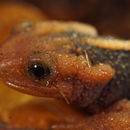Description
provided by AmphibiaWeb articles
This rough-skinned newt has distinct bony ridges on the sides of the top of the head. The body is a dark brownish-black color with orange or yellow pigment on the head (including parotoid glands), vertebral ridge, and dorso-lateral body warts. Most of the venter, tail, and limbs is also orange-yellow in color.The etymology of the name is derived from the Mandarin "shan" (mountain) and "jing" (spirit or demon). This species was described and removed from T. verrucosus (the Burmese Newt) (Nussbaum et al. 1995). Tylototriton verrucosus has protected status but T. shanjing does not, though it has been proposed by Zhao (1998).The taxonomic status of Tylototriton shanjing has recently been disputed. Zhang et al. (2007) recommended that T. shanjing be considered a synonym of T. verrucosus, on the basis of similarity in Cyt b. However, only a single sample of T. verrucosus was analyzed, from China; no samples were included from other parts of the range (India, Nepal, Myanmar, Thailand, Burma, Viet Nam, and probably Laos and Bhutan). In addition, Ziegler et al (2008) report that T. shanjing breeds true in captivity. Until a more thorough analysis of T. verrucosus is undertaken, the systematic decision to remove shanjing must be considered premature. (For an English translation of Zhang et al., e-mail Jennifer Macke, jpmackeATcomcast.net)
- Zhang, M., Rao, D., Yu, G., and Yang, J. (2007). ''The validity of Red Knobby Newt (Tylototriton shanjing) species status based on mitochondrial Cyt b gene.'' Zoological Research, 28(4), 430-436.
- Ziegler, T., Hartmann, T., Van der Straeten, K., Karbe, D., and Böhme, W. (2008). ''Captive breeding and larval morphology of Tylototriton shanjing Nussbaum, Brodie and Yang, 1995, with an updated key of the genus Tylototriton (Amphibia: Salamandridae).'' Der Zoologische Garten, 77, 246-260.
- author
- Meredith Mahoney
- author
- Vance Vredenburg
Distribution and Habitat
provided by AmphibiaWeb articles
This newt is known only from the western Yunnan province in the People's Republic of China in the mountains along the Nu, Lancang, and Yuan rivers (Zhao 1998; Nussbaum et al. 1995).
- author
- Meredith Mahoney
- author
- Vance Vredenburg
Life History, Abundance, Activity, and Special Behaviors
provided by AmphibiaWeb articles
Breeding occurs between May and August, and the eggs are deposited singly or in strings on aquatic plants in ponds or pools (Zhao 1998). This newt is completely terrestrial in the non-breeding season (Zhao 1998).
- author
- Meredith Mahoney
- author
- Vance Vredenburg
Life History, Abundance, Activity, and Special Behaviors
provided by AmphibiaWeb articles
Newt populations are often threatened by human consumption (see "Relation to Humans" section), but are also increasingly threatened by the habitat destruction inflicted by growing human populations (Zhao 1998).
- author
- Meredith Mahoney
- author
- Vance Vredenburg
Relation to Humans
provided by AmphibiaWeb articles
Tylototriton shanjing has a close associations with humans. It is regularly caught and dried for medicinal usage, and because of its beautiful coloration patterns, it is commonly sold in the pet trade industry.
- author
- Meredith Mahoney
- author
- Vance Vredenburg
Tylototriton shanjing: Brief Summary
provided by wikipedia EN
Tylototriton shanjing, the emperor newt, Mandarin newt or Mandarin salamander, is a highly toxic newt native to China.
- license
- cc-by-sa-3.0
- copyright
- Wikipedia authors and editors

